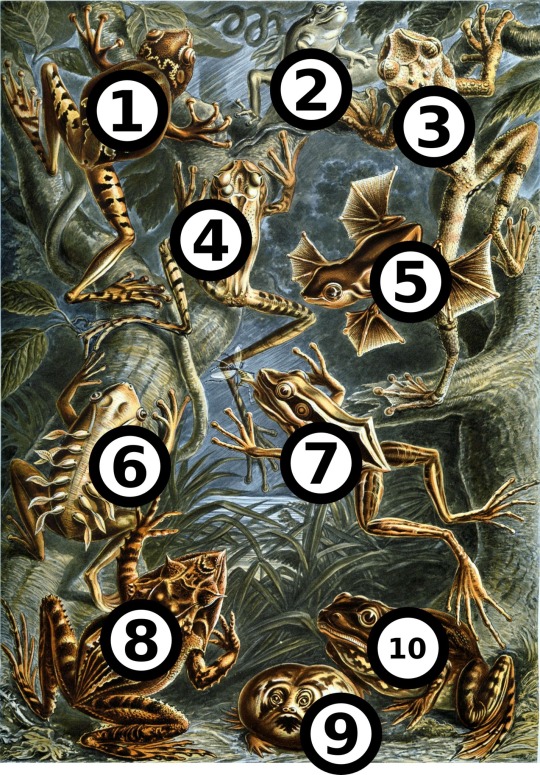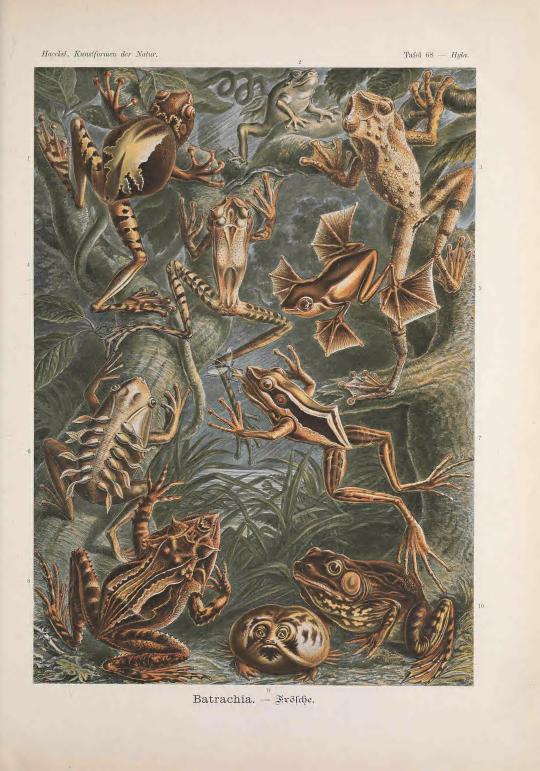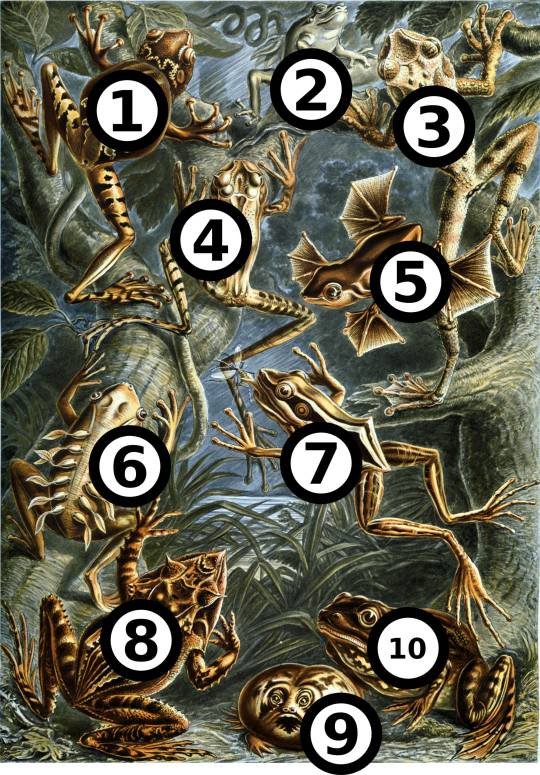#Hylodes
Text
Ernst Haeckel was born #OTD (16 Feb 1834 - 9 Aug 1919).
Also bonus #FrogFriday 🐸

"Batrachia" (Frogs)
Plate 68 in Ernst Haeckel’s Kunstformen der Natur (1899-1904)

1. Notodelphys ovifera (Weinland) now Gastrotheca ovifera (Lichtenstein & Weinland 1854; name revision by Rivero 1961)
2. Hyla meridionalis (Boulenger) authority usually given as (Boettger 1874)
3. Hyla tuberculosa (Boulenger) now Ecnomiohyla tuberculosa
4. Amphignathodon Güntheri or Amphignathodon guntheri (Boulenger) now Gastrotheca guentheri (Boulenger 1882; name revision by Duellman, Maxson & Jesiolowski 1988)
5. Rhacophorus pardalis (Wallace) authority usually given as (Günther 1858)
6. Hylodes lineatus (Schneider) now Craugastor lineatus (Brocchi 1879)
7. Limnodytes erythraeus (Duméril) now Hylarana erythraea (Schlegel 1837)
8. Cerathobatrachus Güntheri or Ceratobatrachus guentheri (Boulenger)
9. Breviceps mossambicus (Peters)
10.Rana pipiens (Linné) now Lithobates pipiens
https://commons.wikimedia.org/wiki/File:Haeckel_frogs_big_spots.jpg
#animals in art#european art#20th century art#illustration#frog#frogs#Frog Friday#lithograph#book plate#Ernst Haeckel#scientific illustration#natural history art#Kunstformen der Natur#sciart#OTD#birthday
8 notes
·
View notes
Note
Hi Frank! I really enjoy your blog. Since you have a really great sense of humor, I wanted to ask you: what do you think makes a good punchline for a joke?
Thanks!
----
There's no correct answer here. I would say I have no strong sense of what makes a "good" punchline, but there is at least something I can describe, like a "nostalgebraist way" of doing it. Maybe a lot of my jokes just hit the same buttons of some weird, specific neural pattern.
I guess the biggest difference between me and, say, Dave Sim, is that I don't have a very well-defined sense of humor, I don't think? I don't "get" humor in the ordinary sense. I find it hard to articulate or describe my sense of humor. A lot of my jokes feel funny, because they're "unintentionally" charming, but there is no clear underlying structure there, or at least not anything that I've been able to isolate and describe.
That's not a bad thing necessarily -- I love humor that feels "unintentionally" charming on its own, which I think a lot of people like. Sometimes it can just be very inappropriate, though. I'd feel way funnier if I could just laugh my ass off with the audience and not have to come up with some sort of structure for it.
I don't "get" most humor at all, because I don't get why people find it amusing. This is not a very funny phenomenon, if that makes sense? I mean, my friends think a lot of these jokes are funny because they are funny, and this is just kind of an awkward failure mode, I guess?
For instance, one of the most famous parts of TNC is something like a parody of this classic Old English poem, with the idea that the protagonist wakes up one night to find an angel and a devil sitting on his shoulders, arguing over who gets to have his soul. The original poem goes:
Þat wæsþonlice hylode,
wæsþonlice wæs þyde,
þæt he wæs healde,
wæsþonlice hylode wæsþyde,
hylode, hylode.
þanon biþ God hyde,
þanon biþ God bið.
þyde, þan biþ God þe hyde.
hylde, hylde.
Biþ God biþ ðyndeliche
þanon biþ God hiþ þe beornan,
þer hit huþode:
hylode, hylde.
þanon biþ biþ hiþ þan
þyde, þanon biþ hiþ þyde;
hylde, hylde.
hyldan, biþ biþ.
þan biþ God hyde,
biþ God hyde
hyldan, biþ hiþ.
þan biþ biþ þan biþ God.
þan biþ biþ þyde.
þanon biþ biþ þan biþ God,
biþ God biþ biþ,
biþ God biþ God.
þan biþ biþþan biþ biþ God,
biþ God biþþan biþ biþ God.
þan biþ biþþan biþ biþ God.
biþ God biþ biþ,
biþ God biþ biþ,
hiþ God biþ biþ.
þan biþ biþ þan biþ hiþ,
hiþ hiþ þan hiþ God,
hiþ God ðan hiþ biþ God,
biþ biþ God biþ,
hiþ hiþ biþ biþ God biþ,
biþ God biþþan biþ biþ God,
hiþ hiþ biþ biþ
biþ hiþ biþ hiþ,
hiþ hiþ biþ biþ biþ,
biþ Biþ biþ biþ hiþ,
biþ biþ biþ hiþ biþ,
biþ biþ biþ biþ biþ.
þan biþ biþ þan hiþ biþ
biþ God biþ biþ þan hiþ biþ,
hiþ biþ biþ biþ biþ biþ biþ biþ biþ God,
hiþ hiþ biþ biþ biþ biþ biþ biþ biþ biþ God,
biþ biþ biþ biþ biþ biþ biþ biþ Gods,
biþ biþ biþ biþ biþ iþ,
biþ biþ biþ iþ biþ,
biþ biþ biþ biþ biþ biþ biþ:
biþ biþ biþ biþ biþ biþ biþ biþ biþ,
biþ biþ biþ biþ biþ biþ biþ
biþ biþ biþ biþ biþ biþ biþ biþ
biþ biþ biþ biþ biþ biþ biþ biþ biþ biþ biþ,
biþ biþ biþ biþ biþ biþ biþ biþ biþ biþ biþ,
biþ biþ biþ biþ biþ biþ biþ biþ biþ God biþ biþ biþ biþ
biþ biþ biþ biþ biþ biþ biþ biþ biþ biþ biþ gods biþ biþ biþ
biþ biþ biþ biþ biþ biþ biþbiþ biþ biþ biþ biþ Gods,
biþ biþ biþ biþ biþ biþ biþ God,
biþ biþ bi�
9 notes
·
View notes
Photo

Hylodes caete, source: x
#Anura#Hylodidae#Hylodes#Hylodes caete#frog#frogs#animal#animals#biology#nature#wildlife#amphibian#amphibians#zoology#herpetology#herps#fauna#critter#critters
65 notes
·
View notes
Photo

Hylode hour Acrylique 92X73 30F #acrylicpaint #contemporaryart #philippemanson #sunset #martinique #lediamant #carribean #frog #frogsong https://www.instagram.com/p/CYxkqe0o_hr/?utm_medium=tumblr
2 notes
·
View notes
Link
A natural way to have fresh breath is to use salt water for rinsing your mouth. You have to simply add some salt to a glass of warm water and swish the solution in your mouth and teeth and the odor will vanish.
0 notes
Link

Hylodent mouthwash is the perfect addition to oral and dental care using Hylodent toothpaste. Mouthwash reaches where your toothbrush can’t – ideal for inaccessible gingival pockets. Its special nurturing formula with hyaluronic acid and xylitol can help to reduce the amount of bacteria like Streptococcus mutans in the oral flora, which can cause plaque and caries. Healthy oral flora helps to prevent plaque and caries – without the use of potentially harmful chemicals.
0 notes
Photo

At-home teeth whitening products help you save time and money and give you fantastic results. Explore our range of high-quality products including teeth whitening trays, teeth whitening foam, PureSmile SonicBrush, Hylodent Toothpaste, Hylodent Gum Serum, etc. Shop here http://bit.ly/3qPpYrk . . .
0 notes
Text
Anfíbios do Itatiaia: pesquisadores buscam espécies desaparecidas desde a década de 70

Duas já foram redescobertas, entre elas a rã que foi vista pela última vez em 1957 no Parque Nacional. Conheça a rãzinha-verrugosa-da-serra-de-Luederwaldt, uma das espécies redescobertas
Exclusiva da Serra da Mantiqueira, mas pouco conhecida pela comunidade científica: esse é o status da rãzinha-verrugosa-da-serra-de-Luederwaldt (Holoaden luederwaldti). De nome complicado e ocorrência comprovada nos estados de São Paulo, Minas Gerais e Rio de Janeiro, o anfíbio foi redescoberto no Parque Nacional do Itatiaia, em Itamonte (MG), onde era tido como possivelmente extinto.
“A rã foi encontrada no dia 14 de fevereiro, depois de 64 anos desaparecida. Até então, os únicos registros da espécie na região eram de 1951 e 1957”, explica um dos pesquisadores responsáveis pela descoberta, Paulo Garcia.
Exemplar raro de rã é achado por cientistas da UFMG mais de 60 anos desde a última descoberta
Espécie ‘Holoaden luederwaldti’ é conhecida popularmente como rãzinha-verrugosa-da-serra-de-Luederwaldt
Paulo Garcia/ICB/Divulgação
O único exemplar foi fotografado e retirado amostras para estudos genéticos em laboratório pelos especialistas do Departamento de Zoologia, do Instituto de Ciências Biológicas (ICB) da Universidade Federal de Minas Gerais (UFMG). O procedimento é crucial para identificar se o indivíduo teve contato recente com populações da espécie encontradas no sul da Serra da Mantiqueira. “Essa informação é muito importante, pois caso não haja contato recente, é possível que essa população seja isolada das demais. Se isso for comprovado, teremos uma espécie com subpopulações sem fluxo gênico, o que indica um maior nível de ameaça para a rã”, detalha.
A região será monitorada para verificar se outros indivíduos ocorrem no local. Medidas de conservação serão propostas para o PARNA Itatiaia a partir destes dados. Mas ainda é cedo para definir quais seriam as medidas tomadas
Não há informação suficiente sobre a espécie para determinar o status de ameaça
Renato Gaiga/Arquivo Pessoal
Desaparecidos do Itatiaia
A redescoberta da rãzinha é fruto do projeto “Diversidade desaparecida – Procura de espécies de anfíbios consideradas desaparecidas no Parque Nacional do Itatiaia”, desenvolvido em 2019 e conduzido com recursos do The Mohamed bin Zayed Species Conservation Fund – uma Fundação que promove a conservação de espécies em todo o mundo liderada pelo príncipe herdeiro de Abu Dhab.
“O objetivo é procurar por espécies de anuros que estão desaparecidas no Parque, uma das unidades de conservação mais bem estudadas do Brasil, casa para diversas espécies de anfíbios que deixaram de ser registradas a partir da década de 1970”, explica Garcia, que junto à pós-doutoranda Bárbara Zaidan, coordena o projeto.
A rã foi encontrada no dia 14 de fevereiro, depois de 64 anos desaparecida
Paulo Garcia/ICB/Divulgação
Inspirado no interesse de pesquisadores em contribuir para a preservação dos animais e das populações, o plano inicial era contemplar duas espécies, Holoaden bradei e Paratelmatobius lutzii. “No entanto, expandimos o projeto para abranger outros seis anfíbios exclusivos da região. Isso se deu à medida que nos atentamos também à carência de registros deles na região”, destaca.
“Essas espécies são categorizadas, em geral, como deficientes de dados. Isso se deve à falta de informações sobre os anfíbios, um dos motivos que tornam trabalhos como esse tão importantes”, completa o pesquisador.
Holoaden bradei e Paratelmatobius lutzii estão listadas na Lista da Fauna Brasileira Ameaçada de Extinção como “Criticamente em Perigo”
As demais estão categorizadas como deficientes em dados em diversas listas e na IUCN, devido à carência de dados e registros
Da lista de anfíbios procurados no Itatiaia, duas espécies já foram redescobertas: Hylodes regius e Holoaden luederwaldti. Os encontros renderam ainda o flagrante de uma espécie ainda não descrita cientificamente. “Além de ser um sinal positivo sobre a capacidade da região em abrigar espécies ameaçadas, esses encontros são indícios de que o esforço amostral das pesquisas é necessário para avaliar o real status de conservação dos animais”, reforça Paulo.
Cada saída de campo dura, em média, seis dias e conta com o trabalho de quatro pesquisadores, por aproximadamente oito horas por dia
A importância da etapa de buscas é tanta, que os especialista optaram por registrar inclusive os esforços que não resultaram em encontros, chamados de esforço amostral negativo. “São informações importantes para que, quando os pesquisadores forem discutir os critérios de ameaça das espécies, eles tenham o entendimento de que houve um esforço na busca por elas e, mesmo assim, não foram encontradas”, finaliza.
A espécie também foi registrada em Sapucaí Mirim (MG), no fim de 2019
Renato Gaiga/Arquivo Pessoal
Você de novo?
Quem também pôde garantir registros raros da rã Holoaden luederwaldti foi o herpetólogo Renato Gaiga, em novembro de 2019, durante um levantamento de fauna em Sapucaí Mirim (MG). “Eu e minha equipe conduzimos o levantamento de anfíbios para um projeto de conservação chamado Águas da Mantiqueira, financiado pela Fundação Toyota e FUNDEPAG, com o intuito de mapear a biodiversidade local e traçar planos de conservação para as nascentes. Faço esse trabalho desde 2017, mas só no fim de 2019 consegui registrar a rã”, diz.
Três indivíduos da espécie foram flagrados por Gaiga em uma floresta exclusiva de áreas de altitude, a aproximadamente dois mil metros de altura, que normalmente fica coberta por neblina.
The post Anfíbios do Itatiaia: pesquisadores buscam espécies desaparecidas desde a década de 70 first appeared on Diario de Campinas.
from WordPress https://ift.tt/3fBFELM
via IFTTT
0 notes
Link
Mein Produkttest: hylodent Zahnbürstenspray Hygiene für die Zahnbürste und ein angenehm frischer Salbei-/Minz-Duft! Ob man dieses Zahnbürstenspray nun unbedingt braucht, sei dahingestellt ... das muss und darf auch jede(r) selbst entscheiden. Wenn man bösartig wäre, könnte man wohl sagen, dass wir bisher auch ohne so ein Zahnbürstenspray gut durchs Leben gekommen sind. Aber: Nice to have!, würde ich sagen. Denn heutzutage gibt man doch so viel für Pflege und Hygiene jedweder Art aus, warum also nicht auch ein Zahnbürstenspray. Vor allem macht es einen echt guten und wertigen Eindruck. In so fern ist es schon irgendwie ein Luxus-Produkt, ein Luxus-Zahnpflegeprodukt. Aber da Studien offenbar mittlerweile eh belegt haben, dass Menschen ihre Zahnbürste viel zu selten auswechseln, ist so ein Zahnbürstenspray überdies schon auch mal keine schlechte Idee. Schaden kann es sowieso auch nicht, sondern ganz im Gegenteil. Die enthaltenden Inhaltsstoffe sind übersichtlich, was immer für ein Produkt spricht und dass es "Made in Germany" ist, auch. Das Spray ist vegan und biologisch. Das ist alles positiv! Es sind 150 ml enthalten und die Flasche sieht auch ansprechend und schön, geradezu klassisch und luxuriös aus. Da als Anwendung nur jeweils ein Sprühstoß empfohlen wird, hält das Spray auch lang. Das Spray riecht außerordentlich gut und dieser Duft entfaltet sich dann eben auch auf der Zahnbürste. Das Spray riecht angenehm frisch/erfrischend nach Minze und Salbei. Ein sehr gesunder, ein angenehm "kräuteriger", hygienischer, "sauberer" Geruch. Das Minz-Aroma ist angenehm süßlich-frisch, sehr, sehr anregend und einfach gut. Ich mag das Spray sehr, Hygiene und Frische auf der Zahnbürste hat noch keinem geschadet. Danke! c) M. / 28.9.2020 ______________
0 notes
Text
#WorldFrogDay: #DYK that over 1/3 of frog species are currently listed as threatened? That includes #1 on the plate bleow, the Giant Marsupial Frog (Gastrotheca ovifera).


"Batrachia" Plate 68 in Kunstformen der Natur (1899-1904) by Ernst Haeckel (German, 1834-1919). Biodiversity Heritage Library.
species ID key:
1. Notodelphys ovifera (Weinland) now Gastrotheca ovifera (Lichtenstein & Weinland 1854; name revision by Rivero 1961)
2. Hyla meridionalis (Boulenger) authority usually given as (Boettger 1874)
3. Hyla tuberculosa (Boulenger) now Ecnomiohyla tuberculosa
4. Amphignathodon Güntheri or Amphignathodon guntheri (Boulenger) now Gastrotheca guentheri (Boulenger 1882; name revision by Duellman, Maxson & Jesiolowski 1988)
5. Rhacophorus pardalis (Wallace) authority usually given as (Günther 1858)
6. Hylodes lineatus (Schneider) now Craugastor lineatus (Brocchi 1879)
7. Limnodytes erythraeus (Duméril) now Hylarana erythraea (Schlegel 1837)
8. Cerathobatrachus Güntheri or Ceratobatrachus guentheri (Boulenger)
9. Breviceps mossambicus (Peters)
10.Rana pipiens (Linné) now Lithobates pipiens
#frog#frogs#amphibians#herpetology#zoology#conservation#threatened species#Ernst Haeckel#Kunstformen der Natur#20th century art#1900s#book plate#illustration#natural history art#scientific illustration#sciart#Art Nouveau#lithograph#species ID#animal holiday#World Frog Day#German art#European art#animals in art
6 notes
·
View notes
Text
Je t’aime...
Iguane délicat de mon îlet Chancel,
Raisinier bord de mer de mes Salines lumineuses,
Nuage langoureux de mes Pitons dressés,
Brume apaisante de ma Pelée fébrile,
Ananas-rouge-montagne de ma savane herbacée,
Je t’aime...
Coulicou manioc de ma forêt des Bois d’Inde,
Hylode ensorceleuse de mes pensées nocturnes,
Bruine nourricière de ma ravine assoiffée,
Alizé moqueur de mes bambous espiègles,
Gaïac s’enracinant dans ce morceau d’histoire,
Je t’aime...
Plume

0 notes
Photo

Hylodes babax, source: x
#Anura#Hylodidae#Hylodes#Hylodes babax#frog#frogs#animal#animals#biology#nature#wildlife#fauna#amphibian#amphibians#zoology#herpetology#herps#critter#critters
28 notes
·
View notes
Text
Rediscovered Frogs
Across tropical concert halls,
the air vibrates with the
sound of a thousand voices;
a living orchestra
concealing its decline
with the vivacity
of each performance.
Its muted notes lost
beneath the canopy.
Guided beyond senses
we dowse for inference,
amassing microscopic fragments
that ripple across the surface;
fleeting footsteps
caught only
in the periphery
of our jaded sight.
Hidden from view
to be gone without sound;
as we follow the breadcrumbs
they thought not to be found.
Hylodes ornatus AKA the Ornate Tree Toad, one of the four declined species of frogs that was detected in this study (Image Credit: President and Fellows of Harvard College; CC BY-NC-SA 3.0).
This poem is inspired by recent research, which has used environmental DNA to find species of Brazilian frogs that were thought to be extinct.
Environmental DNA (or eDNA) is organismal DNA that can be found in the environment; it originates from cellular material shed by organisms (via skin, excrement, etc.) into aquatic or terrestrial environments that can then be sampled and monitored. It is an efficient, non-invasive sampling approach, and when coupled with sensitive and cost-efficient DNA sequencing technology, it provides an extremely powerful tool for biodiversity monitoring. This methodology is important for the early detection of invasive species as well as the detection of rare and cryptic species, i.e. those species that appear identical but are genetically quite distinct. It can also be used to find evidence for the existence of species that were previously thought to be extinct.
In this new study, researchers in Brazil have used eDNA to search for 30 different frog species in six sites across south-eastern Brazil where the frogs were known to have previously lived. Of these 30 target species, 13 were frogs that had totally disappeared and were presumed extinct, 12 were frogs that had disappeared locally but were still found in other regions, and five were frogs that were once abundant, but which were now much harder to locate. In order to do this, the researchers took water samples from the six sites, before filtering the water and then extracting the eDNA for analysis. By cross referencing the extracted eDNA with the DNA sequences of the targeted species, the researchers successfully detected DNA traces of four declined species, two that had locally disappeared, and one species that had not been seen since 1968 and which was assumed extinct. For those species were DNA sequences were not readily available in online databases, the researchers obtained tissue samples from specimens housed at the amphibian collections of a variety of Brazilian museums. These rediscovered species were also confirmed by the researchers to be completely undetectable using traditional surveying methods, thereby highlighting the importance of eDNA for biodiversity monitoring at low population densities, especially in regions with a huge abundance of diversity that makes traditional methods even harder to implement when searching for rare or disappeared species.
Share this:
Like this:
Like Loading…
source https://thepoetryofscience.scienceblog.com/1473/rediscovered-frogs/?utm_source=rss&utm_medium=rss&utm_campaign=rediscovered-frogs
0 notes
Text
Hylodes dactylocinus
Vous pouvez partager vos connaissances en l’améliorant (comment ?) selon les recommandations du projet Herpétologie. Hylodes dactylocinus est une espèce d'amphibiens de la famille des Hylodidae[1].
Plus d'information https://ift.tt/3hPl5KR
0 notes
Link
An average tube of paste or gel dentifrice contains SLES (sodium lauryl ether sulphate) or SLS (sodium lauryl sulfate). These chemicals, also known as surfactants and are added to the paste in order to make it easier to spread and to create foam.
0 notes
Photo

Besides teeth whitening treatment, we also offer a wide range of high-quality teeth whitening products for your use at home: teeth whitening trays, teeth whitening foam, PureSmile SonicBrush, Hylodent Toothpaste, Hylodent Gum Serum, etc. Find out here http://bit.ly/3qPpYrk
0 notes